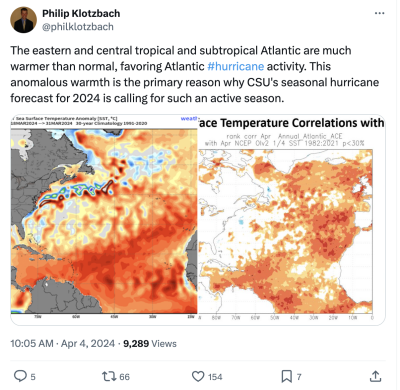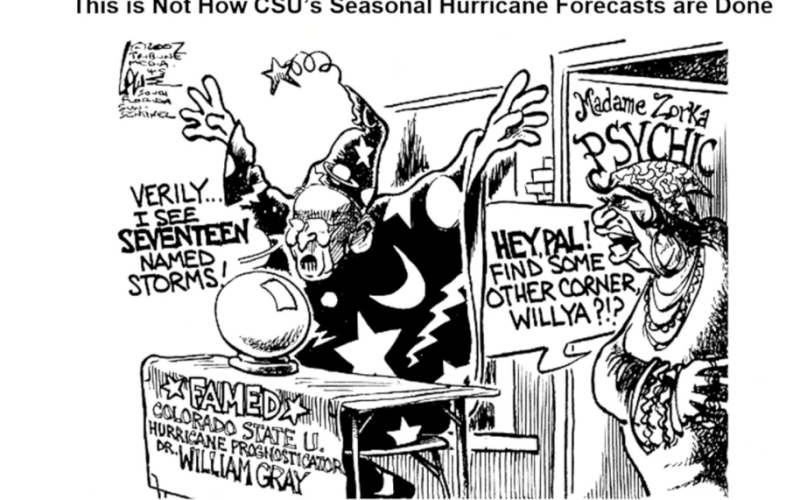The 2024 Atlantic hurricane season that officially opens June 1 could bring 23 named storms and 11 hurricanes, likely to be fueled by record-warm Atlantic sea surface temperatures and shifting conditions in the equatorial Pacific, Colorado State University researchers said in announcing their annual spring forecast.
That compares to an average 14 named storms and 7 hurricanes during 1991-2020. Key factors include an anticipated shift away from El Niño warm-water conditions to La Niña cooling in the Pacific in late summer, which can bring winds across North America favorable for hurricane development.
Atlantic temperatures that have been far above average already this year – potentially energy to fuel hurricane winds.
“This is the highest April forecast we’ve put out” since Colorado State’s annual Atlantic basin forecasts started in 1995, said Phil Klotzbach, a senior research scientist in the Department of Atmospheric Science at Colorado State.
Klotzbach presented the 2024 forecast Thursday morning at the National Tropical Weather Conference on South Padre Island, Texas. The season could bring on 5 major hurricanes, of category 3, 4 or 5 on the Saffir-Simpson scale.
In the 1980s, the late professor Bill Gray of Colorado State began correlating the historic patterns of hurricane seasons with the El Niño and La Niña conditions, the start of a 41-year effort at early seasonal predictions.
Looking to weather records back to 1900, hurricane map tracks show 105 major hurricanes in La Niña years, compared to 45 major hurricanes during El Niño conditions.
Historically the La Niña pattern has favored U.S. East Coast tracks for Atlantic hurricanes, between Florida and Maine, Klotzbach noted.
But forecasters are really focused on those persistent sea surface temperatures in the eastern and central Atlantic, said Klotzbach.
“The Atlantic is still hot. Basically the entire Atlantic is hot right now,” said Klotzbach. “This is the optimum condition for a busy hurricane season.”

“We anticipate that the 2024 Atlantic basin hurricane season will be extremely active,” according to a summary from the Colorado State team. “Current El Niño conditions are likely to transition to La Niña conditions this summer/fall, leading to hurricane-favorable wind shear conditions.”
“Sea surface temperatures in the eastern and central Atlantic are currently at record warm levels and are anticipated to remain well above average for the upcoming hurricane season. A warmer-than-normal tropical Atlantic provides a more conducive dynamic and thermodynamic environment for hurricane formation and intensification.”
The forecast includes “a well above-average probability for major hurricanes making landfall along the continental United States coastline and in the Caribbean.”
In their detailed forecast, the Colorado State team stressed “the record warm tropical and eastern subtropical Atlantic sea surface temperatures are a primary influence in the prediction of 11 hurricanes this year.”
“When waters in the eastern and central tropical and subtropical Atlantic are much warmer than normal in the spring, it tends to force a weaker subtropical high and associated weaker winds blowing across the tropical Atlantic,” according to the report. “These conditions will likely lead to a continuation of well above-average water temperatures in the tropical Atlantic for the peak of the 2024 Atlantic hurricane season.”





